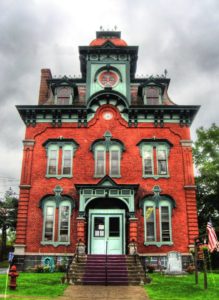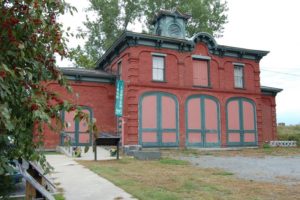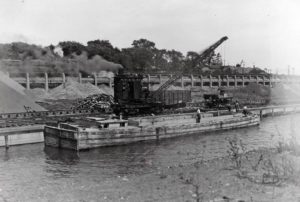Andebit et beaqui corendit, ut quostes esciendion re dit ad et prae parion es quia quas alibus sam, omnim faciden ducipidiat arum autem nobis enis es voat

26. The Witherbees, Sherman & Company Buildings
A Town Celebrates Its History
Listen to the Site 26 Iron Story Audio Narration

Witherbees, Sherman & Company Office Building (Moriah Town Hall): This was the first office of Witherbees, Sherman & Company, appropriately overlooking the lakeside site of production and shipping. Built in 1875, it was designed in the elaborate French Second Empire style, popular from 1865 to 1880. The elaborate details attest to the prosperity of the mining magnates at the time—and their confidence in the industry’s future.
Today it is the Moriah Town Hall. Also on the property to the east is the Witherbee, Sherman & Company carriage house, which was also used as an icehouse and a laboratory for testing iron ore. It now houses the Iron Center Museum. The museum chronicles a century and a half of iron mining history.
The blast furnaces built along the lake by Witherbee, Sherman was the company’s last effort at remaining viable. It is here where we see the beginning and end of Witherbee, Sherman and Company. The company had failed to keep up with the trends in steelmaking. Instead, it attempted to make its higher quality, more expensive ore viable. In addition, the company did not have a well-integrated operation. It had none of the elements that would have helped the company run more efficiently or more effectively: no secondary iron manufacturers nearby to decrease shipping costs. It had to send its raw products to companies downstate or even further, such as Pennsylvania. In addition, it had no nearby source of coal to fuel the furnaces—instead having it shipped up from Pennsylvania.
In contrast, other large iron companies—such as those owned by Andrew Carnegie—were already or were in the process of making themselves fully integrated: owning the coal and iron mines, the shipping company, and the entire means of processing steel—all in one place.
 After a brief burst of profit gained during World War I, Witherbee, Sherman and Company decided to take the risk and build a state-of-the-art furnace. The company borrowed $5 million and began construction. The furnace was completed and ready for production in 1923/24—about the same time that the iron industry peaked. Nevertheless, the company kept trying to improve production and remain in operation. The owners remained hopeful, even expanding the workforce in town. And when immigration restrictions increased after World War I, the company began recruiting blacks from the south. Yet it would all turn out to be too little too late.
After a brief burst of profit gained during World War I, Witherbee, Sherman and Company decided to take the risk and build a state-of-the-art furnace. The company borrowed $5 million and began construction. The furnace was completed and ready for production in 1923/24—about the same time that the iron industry peaked. Nevertheless, the company kept trying to improve production and remain in operation. The owners remained hopeful, even expanding the workforce in town. And when immigration restrictions increased after World War I, the company began recruiting blacks from the south. Yet it would all turn out to be too little too late.
When the Great Depression struck in the 1930s, the company had a difficult time operating at a profit, shutting down the mines for long periods at a time. In 1939 as American industry began gearing up for World War II, Republic Steel leased the Witherbee, Sherman mines and facilities, modernizing them into profitability. By the 1960s, though, the mines had gone so deep underground that it took workers an hour and a half just to get from the surface to their work sites. The profits became slimmer and slimmer each year until finally, in 1971, Republic Steel closed the Moriah mines.

Travel Tools
The Moriah town hall (former Witherbees, Sherman, and Company office building) and the Port Henry Iron Center Museum (34 Park Place, Port Henry) are right next door to each other. You can learn more about the museum here and at the town website.![]()


